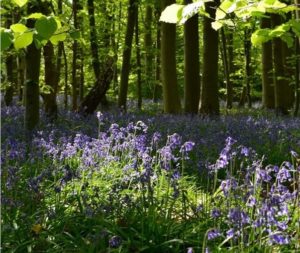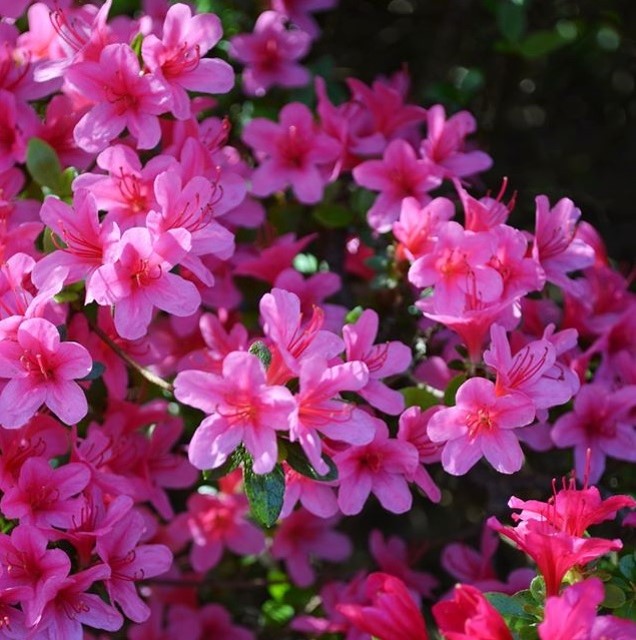Photo: Isabella blooms in May, © The Royal Parks
The Park in Lock-down
It’s now 5-6 weeks since the Park was closed to cars and bikes and aircraft noise largely ceased. While initially there were problems with visitors’ social distancing, that steadily reduced and the Park settled down to its new existence under lock-down. The changes have disadvantaged many people, but for those who are able to come to the Park it is the most tranquil and relaxing that anyone can remember. And new sights have emerged. There has been an explosion in the number of young families, walking or running together and the younger children riding (or learning to ride) their bikes on the now-quiet roads. People stroll along the roads; talk to each other as they stroll; and many acknowledge each other as they pass at the required distance. There is much less deer harassment, no off-track cycling and less disturbance of skylarks – and the birdsong is much more noticeable (and it seems much sweeter!). It’s a very different Park than before and raises the question of what type of Park we want when we emerge from the lock-down.
Dogs and deer
In the last few weeks, incidents of dogs chasing deer and dogs attacking deer and other wildlife seem to have increased substantially. Three particular incidents resulted in a serious risk of human injury, terrified wildlife and a deer death:
- In mid-April, two people were out for a walk with their 18 month old daughter near Sawyers Hill when a large herd of deer chased by a dog stampeded towards them; they tried to outrun the herd, then crouched down and stayed still and eventually found a tree for protection. The dog continued to chase the deer for at least 5 minutes, with the terrified deer running through walkers trying to escape. The owner arrived after a police buggy managed to separate the herd from the dog.
p - Last Wednesday morning, a dog attacked a swan in Adams Pond (near Sheen Gate) and the two were fighting in the middle of the water. Although the swan was able to escape from the dog’s clutches and the dog was retrieved by its owner, another dog then went into the pond and attacked the swan and other wildfowl. This incident is very reminiscent of attacks on swans at Pen Ponds last summer.
p - Last Thursday evening, a dog attacked a fallow deer near Pen Ponds, having run some distance. It was pulled off the deer by a member of the public (the owner nowhere to be seen) and ran away but then came back to savage the deer again. The attack was described by witnesses and the police as ‘sickening’ and ‘as nasty as it gets’ and the deer had to be put down; the owner will be subject to further action by the Police and The Royal Parks.
In the last week, TRP and the Friends have received several videos of dogs chasing deer; see video: Dog out of control in Richmond Park, chasing deer.
These kind of dog attacks and dogs chasing deer are clearly unacceptable and a major concern especially as we are entering the deer birthing season. The vast majority of dog owners are responsible and careful to keep their dogs under control and avoid deer. But there seems to be an increasing minority who are not. Please be doubly careful to keep your dog under control for the next couple of months.
And if you see a dog chasing or attacking deer or other wildlife please phone the police mobile on 07920 586546 (only use this number for serious situations). Please take photos or a video of the incident including the dog and if possible the owner so that these are evidence for the police and email them to [email protected].
Reporting the incident with no evidence when you get back home is not of much use other than to add to the statistics. Please be careful not to put yourself under any personal risk.
Isabella Plantation in Lock-down
We are all missing the Isabella Plantation, bursting with brightly coloured blooms at this time of year. So, Jo Scrivener, the Assistant Park Manager in charge of Isabella has created an Instagram page for the beautiful photos of plants in bloom he’s taken in recent days. Each photo has information about the plant. He plans to add more as the season progresses.
If that doesn’t satisfy you, there is also a video of Isabella taken at this time last year by Amanda Boardman and more Isabella photos on the Friends’ Facebook and Instagram pages:
- The Friends’ Facebook (now with over 11,000 followers!)
- The Friends’ Instagram (a recent addition to our media and rapidly growing in popularity)
Quizzes: 100 Questions about the Park
As our contribution to getting through the lock-down, the Friends has now published 4 general knowledge quizzes about the Park, with 100 questions in all, to test your knowledge of our National Nature Reserve. This is great fun for all the family. You can find all 4 quizzes here. Watch out for more…
A wild goose chase
A member of the Friends’ Bird Group recently came across an Egyptian Goose and her family of 13 goslings that were being playfully harassed by a group of children. The distracted birds started heading for the exit at Sheen Gate. But with a bit of quick thinking and careful manoeuvring he managed to get them to turn around and head towards nearby Adam’s Pond. Photographer Amanda Boardman was on hand to help with the process and she shot this video of the rescued creatures, and saw them launch into the pond and then march off to the next one. A happy ending, and the children, looking on, learned a lot too!
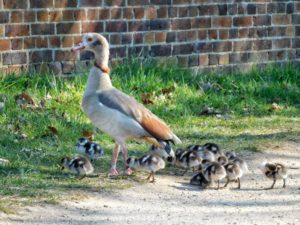
Tree of the Month
The May Tree of the Month is the majestic Horse Chestnut. Read interesting facts about it in our specially prepared fact sheet – its origins, value to wildlife, how we use it and where to see fine examples.
A Year in Richmond Park
We think you will enjoy this new short film by Olly Johnson as much as we did; it’s not too long – 7min: 43secs. Recommended! A Year in Richmond Park.
Grass Snake
We know there are grass snakes in the Park, but how often do we see them? This one was spotted on 4th May by Rebecca Dunne on a path between Ladderstile Gate and Dann’s Pond, and was about 3 feet long. They generally grow to 3-5 feet long and live for an average of 15-25 years. Click on the photo for more information on grass snakes.
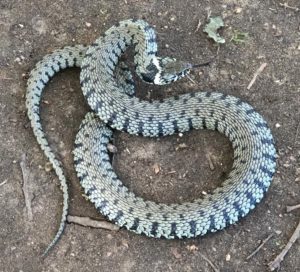
2021 Calendar – Closing date for photos
There’s still time to send in your photos for next year’s Friends’ Calendar. Closing date is 15 May 2020. Full details here.
Richmond Park Police Panel
The early-April meeting of the Safer Parks Police Panel (SPP) was cancelled due to the Covid-19 pandemic. However, the 15 members did get the police activity reports for Jan-March.
- Initially, the Park Police focused on the usual seasonal wildlife and ecology protection issues.
- They spoke to people over 600 times about the dangers of approaching/feeding deer and about 120 times to dog owners about off-lead dogs (the Pen Ponds area is now dogs on leads 365 days a year, dogs continue to worry and chase deer, and the protected skylark areas came into force from 1st March).
- Cycle speed was again an issue – with 250 police actions – car parking saw about 300 actions, and trade vehicles (a never-ending problem, and a Jan-Mar SPP priority) almost 500 stopped.
But everything changed on 23 March when the Park was closed to vehicles, and then on 27th March when it was closed to adult cycling too. The Parks Police priorities turned abruptly to focusing on compliance with the Covid-19 controls, incl. by the end of March the police recording 115 cases of cyclists not complying with the restrictions.
I-Spy Butterflies!
For Discoverers families and all fortunate enough to be able to walk in the Park, the butterfly season is now well underway. Thanks to April sun, we are seeing favourites like Speckled Wood, Small Copper, and now is the time to look out for the beautiful Painted Lady. In some years this annual migrant to the UK arrives in large numbers. Its journey to Europe from North Africa is remarkable – these fragile creatures can cover a hundred miles a day at speeds of around thirty miles an hour! Look for them around thistles and nettles. In fact, why not put the irecord butterflies app on your phone and learn to recognise and record your observations for Butterfly Conservation?
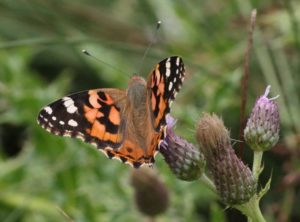 Painted Lady (Simon Silvester)
Painted Lady (Simon Silvester)
May in the Isabella Plantation
The Isabella Plantation remains closed but, as mentioned above, you can see photos of the plants in bloom in the new Instagram page created by Assistant Park Manager, Jo Scrivener who is responsible for the Isabella Plantation.
Here’s what you would normally see this month:
Evergreen Azaleas
- ‘Orange Beauty’, the most orange of all
- ‘Rosebud’, opening buds resemble tiny roses
- ‘Palestrina’, white with a faint ray of green
- ‘Vuyk’s Scarlet’, large flowers of a deep silky red
- ‘Hinode Giri’, bright crimson, around the Still Pond
Deciduous Azaleas
These flower slightly later and often have a rich spicy smell, particularly Azalea pontica, (Rhododendron luteum), which is yellow.
The Bog Garden
Euphorbia griffithii ‘Fireglow’, growing in the bed by the middle pond it bares orange-red flowers and has a reddish tinge to the emerging young shoots. Alongside the margins of pools and streams grows the “Japanese Primrose”, Primula japonica ‘Millers Crimson’ with its whorls of crimson flowers which are borne in profusion on tall stems, from May to July. Also present are the young fronds of the “Shuttlecock Fern”, Matteuccia struthiopteris which show an attractive fresh green. Growing either side of the main pool is the “Ornamental Rhubarb”, Rheum Palmatum a robust herbaceous perennial with broad, architectural foliage and pink flowers on large erect panicles.
The native tree the “Whitebeam”, Sorbus aria grows near the Broomfield Hill gate and looks particularly attractive at this time of the year with its silvery-white young leaves. Skimmia japonica can also be found growing near this gate along the path that leads onto Camellia Walk and the Still Pond
The “Foxglove Tree”, Paulownia tomentosa stands in the glade between the Still Pond and Old Nursery Glade. This large leaved tree bares sprays of fragrant foxglove-like pinkish-lilac flowers in Spring.
The “Pocket Handkerchief Tree”, Davidia involucrata, set back from the Camellia Walk, has intriguing white hanging bracts. Another specimen may be found in a secluded lawn to the southeast of Thomson’s Pond.
The “Snowdrop Tree”, Halesia carolina, with dangling white bell flowers, stands by the path above Thomson’s Pond.
Cornus nuttallii, whose white bracts appear like flowers, can be found set back in the newly planted Magnolia Glade near the Ham Gate entrance. Also look out for the pale lemon yellow fragrant flowers of Magnolia wilsonii ‘Yellow Fever’ and the wonderful deep purple flowers of Magnolia liliiflora ‘Nigra’.
Bluebells carpet the wilder fringes of the Garden.
